The AMD Radeon R7 265 & R7 260 Review: Feat Sapphire & Asus
by Ryan Smith on February 13, 2014 8:00 AM ESTPower, Temperature, & Noise
As always, last but not least is our look at power, temperature, and noise. Next to price and performance of course, these are some of the most important aspects of a GPU, due in large part to the impact of noise. All things considered, a loud card is undesirable unless there’s a sufficiently good reason – or sufficiently good performance – to ignore the noise.
| Radeon R9 270 Series Voltages | ||||
| AMD R7 270 Boost Voltage | Sapphire R7 265 Boost Voltage | Asus R7 260 Boost Voltage | ||
| 1.188v | 1.175v | 1.225v | ||
Neither the R7 260 nor the R7 265 are remarkable as far as voltages are concerned. Both of these are right in the range of common voltages for lower clocked Pitcairn and Bonaire products respectively. Though this does reinforce the fact that R7 265 won’t see any significant power savings compared to R9 270.
| Radeon R9 270 Series Average Clockspeeds (Reported) | ||||
| Sapphire R7 265 | Asus R7 260 | |||
| Boost Clock | 925MHz | 1000MHz | ||
| Metro: LL |
925MHz
|
1000MHz
|
||
| CoH2 |
925MHz
|
1000MHz
|
||
| Bioshock |
925MHz
|
1000MHz
|
||
| Battlefield 4 |
925MHz
|
1000MHz
|
||
| Crysis 3 |
925MHz
|
1000MHz
|
||
| Crysis: Warhead |
925MHz
|
1000MHz
|
||
| TW: Rome 2 |
925MHz
|
1000MHz
|
||
| Hitman |
925MHz
|
1000MHz
|
||
| GRID 2 |
925MHz
|
1000MHz
|
||
Looking briefly at average clockspeeds, despite the fact that these cards implement different power control mechanisms – PowerTune Boost 1.0 and PowerTune Boost 2.0 respectively – the end results are the same. Neither card has difficulty maintaining its top clockspeed for their entire runs, this owing in large part due to the fact that they’re not under any significant thermal load that would require pulling back.

Starting as always with idle power consumption, we can see that all of our low-end cards are tightly clustered. With idle power consumption as good as it is for both AMD and NVIDIA, further improvements are relatively marginal by desktop standards and are essentially drowned out by the large PSU in our GPU testbed.

Power consumption under Crysis 3 closely mirrors relative performance, at least for our current-generation 28nm cards. The R7 260 for its part draws 196W at the wall, 15W-23W more than the R7 250X and GTX 650 cards it clearly outclasses, and 5W more than the GTX 650 Ti that it still manages to consistently beat. More interesting is that it’s drawing 26W at the wall less than the R7 260X, showcasing that AMD’s power numbers for these cards were in fact almost spot on, especially after accounting for the change in CPU power consumption.
Otherwise for the R7 265, we can see that power consumption slots in above the 7850 and R7 260X, and below the R9 270 by 9W, the kind of very limited change we were expecting. At the same time we can see just how close the R7 265 and GTX 660 are – separated by just 4W – which goes hand-in-hand with their similar performance.
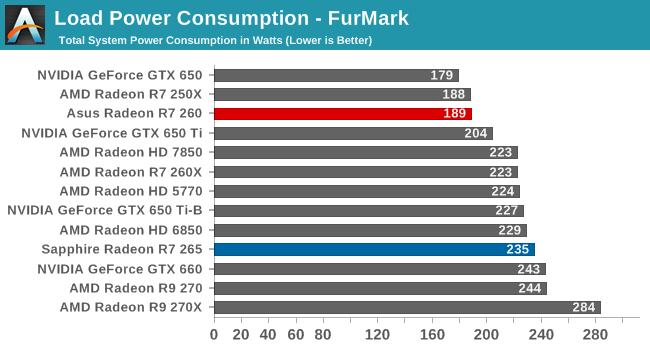
Under FurMark we do see some shifts in relative power consumption, though not relative rankings. At 189W the R7 260 is virtually tied with the less powerful 250X, underscoring Bonaire’s greater efficiency and improved power throttling mechanisms, while the 235W R7 265 once again slots in between the R7 260X and R9 270 by several watts in each direction.
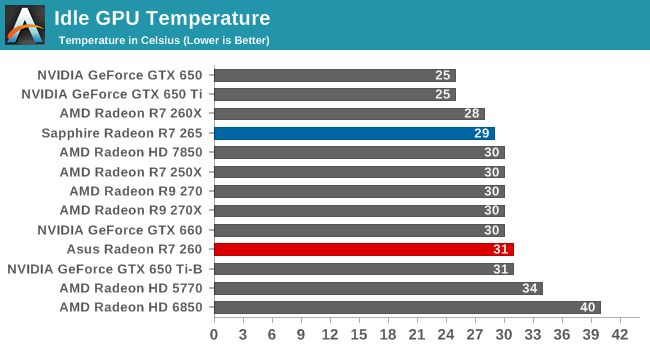
Moving on to temperatures, our idle temperatures are unremarkable. At 29C for the R7 265 and 31C for the R7 260 both cards do well enough, but they can’t touch the near room temperature operating temperatures of some of the NVIDIA 650 cards.
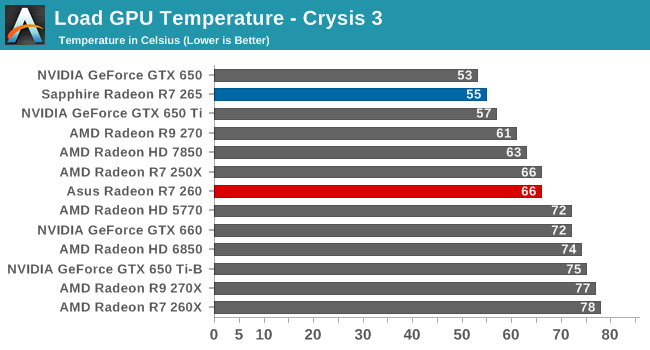
With both of today’s cards being low power open air cooled dual fan cards, there’s little concern for temperatures. Both cards are easily below 70C, with the more powerful R7 265 easily dropping to 55C due to its larger cooler. The R7 260 hits 66C despite its relatively low power, though Asus has clearly been targeting a balance between noise and temperatures as opposed to just maximum cooling in their more recent designs.
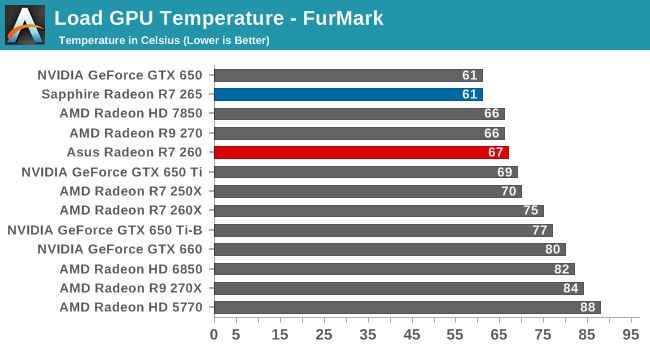
Of our two cards, the R7 265 gets the worse of FurMark relatively speaking, thanks in part to its coarser power throttling mechanisms. Regardless even when presented with a maximum load, both cards do well for themselves here, having no trouble staying below 70C.
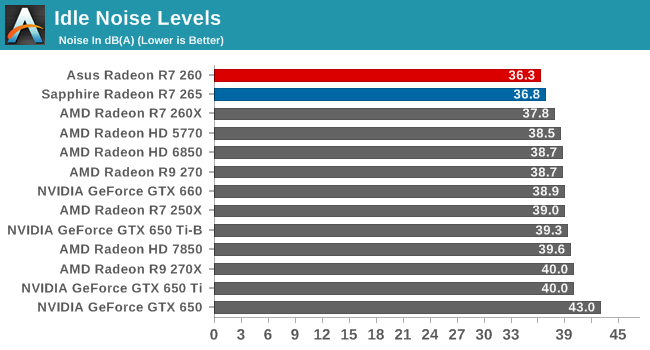
Last but not least we have our noise testing. Both the R7 260 and R7 265 do very well for themselves at idle, taking the #1 and #2 spots respectively. Both of these cards are functionally near-silent at idle, and this proves that both Asus and Sapphire did their homework by being able to hit these noise levels with a dual fan configuration, something not every vendor has had a ton of luck with over the years.

Once again both of today’s cards do very well here. Though the R7 260 is admittedly among the lowest powered cards here, and hence has the easiest time, it nevertheless takes the top spot at 38dB. This being quieter than both the GTX 650 and GTX 650 Ti, the two cards it’s closest to in power consumption and heat generation.
Meanwhile at 40.4dB is the R7 265, where Sapphire has managed to stay cool and quiet despite the nearly 150W the card can pull. At this point it’s still marginally quieter than the slower 260X and over 6dB quieter than the performance-competitive GTX 660 (though it should be noted that the GTX 660 is a blower).
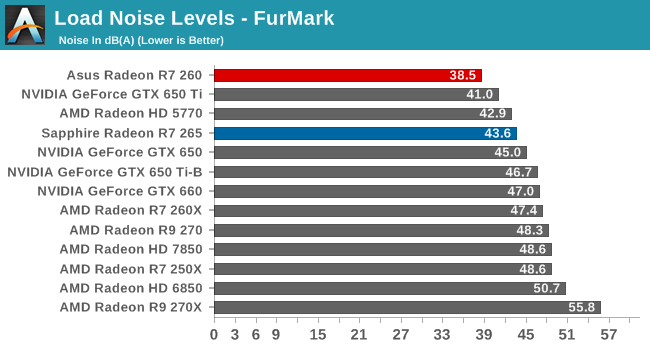
FurMark once again changes the picture, but only slightly slow. Even under this extreme workload Asus’s R7 260 comes away smiling, topping out at 38.5dB, 2.5dB less than the GTX 650 Ti. Otherwise we have the Sapphire R7 265 at 43.6dB, which gives up some of its edge from earlier but not much, easily besting the GTX 660 and R7 260X, but falling a bit short of the GTX 650 Ti.
Taken in altogether, both Asus and Sapphire have done good jobs with their R7 260 and R7 265 respectively. As we’ve seen both are able to hit low noise levels even for their relative classes, all the while easily maintaining low operating temperatures.
Otherwise from a power perspective as neither card is based on a new GPU, there are admittedly no real surprises to be had. Power roughly scales with performance, with the R7 265 as a 3rd tier part seeing a lesser benefit, and thereby falling a bit behind the efficiency curve as set by the higher tier Pitcairn parts.










52 Comments
View All Comments
Death666Angel - Thursday, February 13, 2014 - link
Who is surprised by that? No one that is following GPU reviews since multi-monitors became a thing for the consumer crowd. The first few generations had issues with monitors flickering in a multi-monitor setup because of too aggressive down clocking, so now they are being very conservative there and increase the clocks quite a bit.Solid State Brain - Thursday, February 13, 2014 - link
I don't think it's acceptable, though. AMD might have reduced idle consumption when a single monitor is being driven, but is still neglecting other usage scenarios that are becoming increasingly common. It's not even just a small power difference, especially with medium to high-end video cards.Da W - Thursday, February 13, 2014 - link
STFU.Anandtech had no problem calling 290 - 290X a terrible card because of its blower and the NOISE and crowning Nvidia once again. Much more now with AMD price hike.
The only biased guy here is YOU Nvidia fanboy.
silverblue - Thursday, February 13, 2014 - link
I don't think the price hikes are AMD's fault per se, however considering the inflated prices due to bitmining, you'd definitely want a better cooler than the stock one. The third party cards handle this nicely.Da W - Thursday, February 13, 2014 - link
My last post was directed to HisDivineOrder but the reply button doesn't seem to place my reply below his post.formulav8 - Thursday, February 13, 2014 - link
They always complain when something good is said about AMD whether the good is justified or not justified. They don't care either way.SolMiester - Thursday, February 13, 2014 - link
If this is just the 7xxx rebadge, then I guess it has the same multi GPU frame pacing issues....LOL, why dont they fix the damn thing FFS!...no CF Eyefinity, no DX9 pacing.....still shit!fiasse - Thursday, February 13, 2014 - link
Typo 'and R7 270 holding at $179 (MSRP)'Mr Perfect - Thursday, February 13, 2014 - link
With the naming of the card being so close to the 260X, I was really hoping this would be a faster GN1.1 part. How does AMD expect TrueAudio to catch on if they keep releasing card that don't support it? Hopefully the 300 series will sort this out and I can grab one to play Thief on.fiasse - Thursday, February 13, 2014 - link
looks like another typo on Asus R7 260 page, 'but this is an especially treacherous position if R7 260X prices quickly come down to $199.'